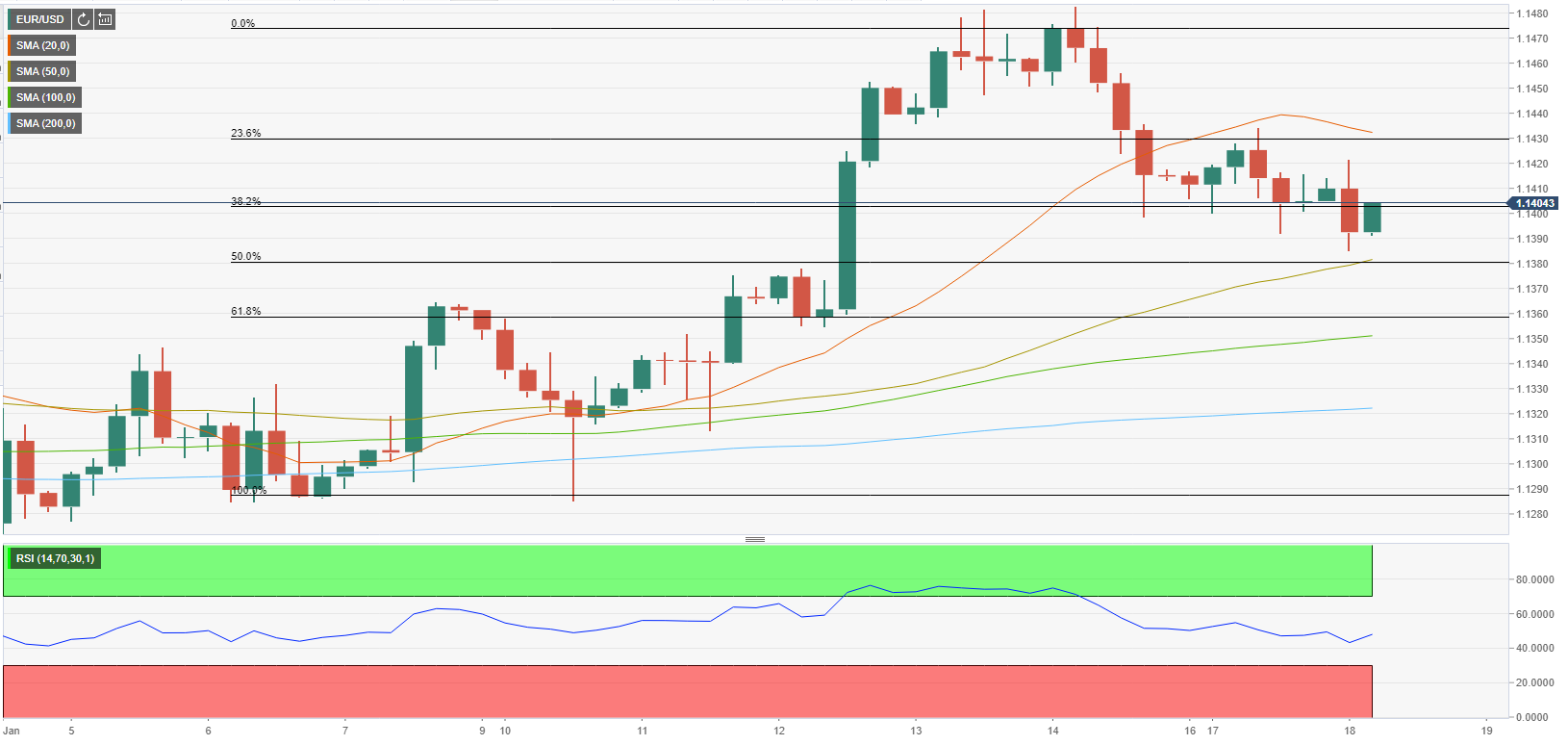- EUR/USD has extended downward correction after closing modestly lower on Monday.
- Surging US Treasury bond yields support the greenback early Tuesday.
- Souring market mood could put additional weight on the euro's shoulders.
EUR/USD has come under bearish pressure early Tuesday after posting small daily losses on Monday. With the dollar continuing to gather strength on rising US Treasury bond yields, the pair is testing 1.1400 early Tuesday and a drop below 1.1380 could open the door for additional losses in the near term.
Following a three-day weekend in the US, the benchmark 10-year US T-bond yield surged higher on Tuesday and reached its strongest level in two years near 1.85%. The US Dollar Index, which touched its lowest level in more than two months at 94.62 on Friday, climbed to 95.50 during the Asian trading hours to highlight renewed dollar strength.
The souring market mood, meanwhile, is making it difficult for the shared currency to attract investors. Escalating geopolitical tensions amid the Russia-Ukraine conflict have caused market participants to seek refuge and US stocks futures have declined between 0.2% and 1%.
Later in the session, ZEW Survey results for the euro area and Germany will be watched closely by market participants. The Economic Sentiment Indicator in Germany is expected to rise in January but it is forecast to decline modestly in the eurozone. Unless these data reveal a convincing improvement in confidence, the shared currency is unlikely to capitalize on them. The US economic docket will feature the Federal Reserve Bank of New York's Empire State Manufacturing Survey.
EUR/USD Technical Analysis
The pair is currently trading near 1.1400 - Fibonacci 23.6% retracement of the uptrend that started on January 6 and lasted for a week. In case this level turns into resistance, the next support aligns at 1.1380 (50-period SMA on the four-hour chart, Fibonacci 50% retracement). With a decisive drop below that level leading to additional losses toward 1.1350 (100-period SMA, Fibonacci 61.8% retracement could be witnessed).
On the upside, buyers could show interest in the common currency if 1.1400 proves to be stronger support than it appears. 1.1430 (20-period SMA, Fibonacci 23.6% retracement) could be seen as the next hurdle in a bullish scenario.
The lack of momentum in either direction, as mirrored by the flat Relative Strength Index (RSI) near 50, suggests that 1.1400 has become a pivot point in the near term.
Information on these pages contains forward-looking statements that involve risks and uncertainties. Markets and instruments profiled on this page are for informational purposes only and should not in any way come across as a recommendation to buy or sell in these assets. You should do your own thorough research before making any investment decisions. FXStreet does not in any way guarantee that this information is free from mistakes, errors, or material misstatements. It also does not guarantee that this information is of a timely nature. Investing in Open Markets involves a great deal of risk, including the loss of all or a portion of your investment, as well as emotional distress. All risks, losses and costs associated with investing, including total loss of principal, are your responsibility. The views and opinions expressed in this article are those of the authors and do not necessarily reflect the official policy or position of FXStreet nor its advertisers. The author will not be held responsible for information that is found at the end of links posted on this page.
If not otherwise explicitly mentioned in the body of the article, at the time of writing, the author has no position in any stock mentioned in this article and no business relationship with any company mentioned. The author has not received compensation for writing this article, other than from FXStreet.
FXStreet and the author do not provide personalized recommendations. The author makes no representations as to the accuracy, completeness, or suitability of this information. FXStreet and the author will not be liable for any errors, omissions or any losses, injuries or damages arising from this information and its display or use. Errors and omissions excepted.
The author and FXStreet are not registered investment advisors and nothing in this article is intended to be investment advice.
Recommended Content
Editors’ Picks
EUR/USD extends gains above 1.0700, focus on key US data

EUR/USD meets fresh demand and rises toward 1.0750 in the European session on Thursday. Renewed US Dollar weakness offsets the risk-off market environment, supporting the pair ahead of the key US GDP and PCE inflation data.
GBP/USD extends recovery above 1.2500, awaits US GDP data

GBP/USD is catching a fresh bid wave, rising above 1.2500 in European trading on Thursday. The US Dollar resumes its corrective downside, as traders resort to repositioning ahead of the high-impact US advance GDP data for the first quarter.
Gold price edges higher amid weaker USD and softer risk tone, focus remains on US GDP

Gold price (XAU/USD) attracts some dip-buying in the vicinity of the $2,300 mark on Thursday and for now, seems to have snapped a three-day losing streak, though the upside potential seems limited.
Injective price weakness persists despite over 5.9 million INJ tokens burned

Injective price is trading with a bearish bias, stuck in the lower section of the market range. The bearish outlook abounds despite the network's deflationary efforts to pump the price.
US Q1 GDP Preview: Economic growth set to remain firm in, albeit easing from Q4

The United States Gross Domestic Product (GDP) is seen expanding at an annualized rate of 2.5% in Q1. The current resilience of the US economy bolsters the case for a soft landing.
